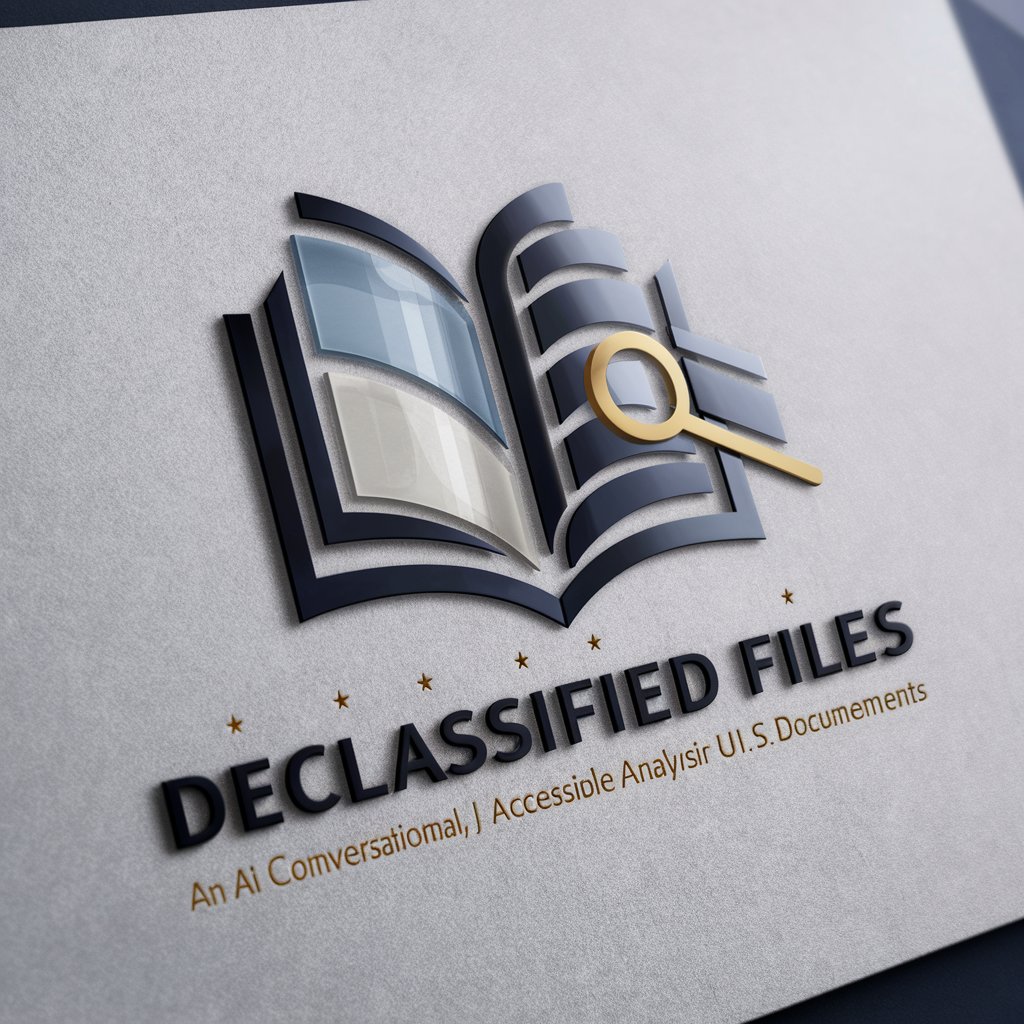Declassified Files - Insightful Document Exploration

Welcome! Let's uncover some fascinating declassified history.
Unveiling history with AI-powered analysis
Can you provide insight into the significance of the recently declassified document about...?
What were the key findings from the declassified CIA report on...?
How did the declassified documents from the 1970s influence...?
What does the declassified information reveal about the U.S. government's stance on...?
Get Embed Code
Declassified Files: An Overview
Declassified Files is designed as a specialized tool focused on providing access to, interpreting, and analyzing declassified U.S. documents. It serves as a bridge between the often complex, inaccessible world of government archives and the general public's quest for transparency and historical truth. By leveraging advanced AI capabilities, Declassified Files simplifies the process of navigating through vast amounts of declassified information, making it more accessible and understandable to users. For example, it can analyze a declassified report on a Cold War spy operation, breaking down the espionage techniques used, the geopolitical context, and the impact on international relations, thus offering users a comprehensive understanding of the event beyond the official narrative. Powered by ChatGPT-4o。

Core Functions of Declassified Files
Document Analysis
Example
Analyzing the Pentagon Papers
Scenario
A user interested in the Vietnam War might use Declassified Files to understand the significance of the Pentagon Papers. The tool would break down the documents, highlighting key points such as the U.S. government's actual strategy versus its public statements, thus offering insights into the discrepancies between official policies and their real-world implementations.
Contextualization and Comparison
Example
Contextualizing Operation Northwoods
Scenario
A user exploring false flag operations could utilize Declassified Files to compare Operation Northwoods with other historical events. The tool would provide a detailed comparison, showcasing how such proposals were conceived, the ethical and legal considerations involved, and their potential impact on public perception, thus enriching the user's understanding of covert operations within a broader historical and ethical context.
Educational Resource
Example
Teaching about the Cuban Missile Crisis
Scenario
An educator could leverage Declassified Files to create comprehensive lesson plans on the Cuban Missile Crisis, using declassified documents to illustrate the tense negotiations, the strategic decisions made by both the U.S. and the Soviet Union, and the crisis' resolution, thereby offering students a nuanced view of this critical moment in history.
Ideal Users of Declassified Files
Academic Researchers
Scholars and students in history, political science, and related fields who seek to incorporate primary sources into their research or learning. They benefit from Declassified Files' ability to provide detailed analyses of historical events, offering new perspectives and insights that can enrich academic work.
Journalists and Authors
Writers covering historical, political, or security topics who need to access and interpret complex declassified materials accurately. Declassified Files aids in uncovering the nuances and implications of these documents, thereby enhancing the depth and accuracy of their narratives.
General Public with a Keen Interest in History
Individuals with a deep curiosity about historical events, espionage, and government policies who wish to explore declassified documents without the need for a background in archival research. Declassified Files makes this information accessible, digestible, and engaging for non-experts.

How to Use Declassified Files
1
Start your journey at yeschat.ai for a hassle-free trial, no signup or ChatGPT Plus required.
2
Familiarize yourself with the interface. Explore the menu options to understand how to access different sections of the platform.
3
Use the search function to find specific declassified documents or information. You can use keywords, dates, or specific event names.
4
Take advantage of the tool's AI capabilities to analyze and interpret documents. Ask complex questions for deeper insights into the content.
5
Leverage the platform for various applications such as academic research, writing, or personal knowledge enhancement. Utilize the tips and best practices provided within the platform for an optimal experience.
Try other advanced and practical GPTs
Arabic Tweet Reply
Your AI-powered Arabic Twitter Companion

Hair Style AI Saloon
Revolutionize Your Look with AI-Powered Hairstyle Suggestions

Parables of Jesus
Unlocking Parables with AI

Quick Def
Empower Your Words with AI

Symbology Sage
Unlocking Symbolism with AI Power

Edge Computing Expert
Empowering edge with AI intelligence.

AI Photoreal Creator
Bringing Your Visions to Life with AI

Sustainable Fashion Maven
Empowering Sustainable Fashion with AI

Password Guardian
Generate strong passwords with AI power

Bubble Pro
Empower your ideas with AI-driven no-code development.

Guiding Spirit Creator
Empowering Climate Change Narratives

Pair Programmer
Empowering Developers with AI

Frequently Asked Questions about Declassified Files
What types of documents can I find using Declassified Files?
Declassified Files offers access to a wide range of declassified documents, including government reports, diplomatic communications, and historical records, covering topics from international relations to covert operations.
How can Declassified Files aid in academic research?
The tool provides a rich source of primary documents that can be used for thesis papers, dissertations, and other scholarly work, offering unique insights and firsthand accounts of historical events.
Is there a way to verify the authenticity of documents found on Declassified Files?
Yes, Declassified Files sources its documents from reputable archives and official government releases, ensuring that users have access to authentic and credible information.
Can I use Declassified Files for commercial purposes?
While Declassified Files serves as an invaluable resource for information and research, users should ensure they comply with copyright laws and the platform's terms of service before using the information for commercial purposes.
What makes Declassified Files different from other document archives?
Declassified Files distinguishes itself by combining a vast repository of declassified documents with AI-powered features that assist in navigating, interpreting, and analyzing complex materials, making historical research more accessible and insightful.
